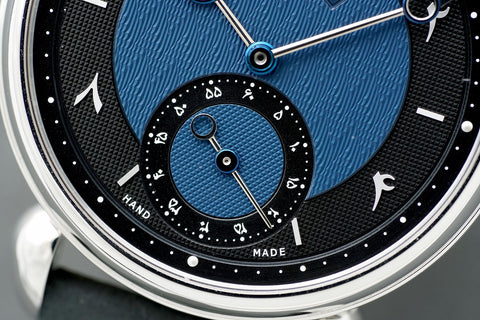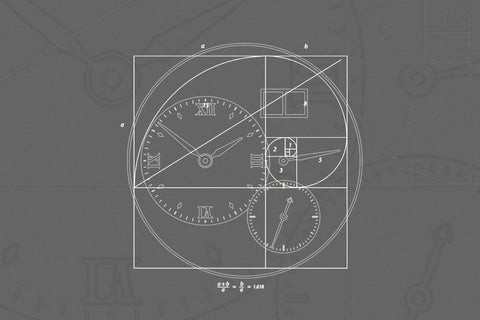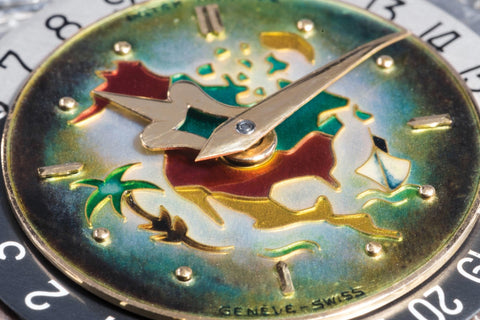
The Bare Bones Of the Skeletonised Watch
By Josh Sims
“When I started out at the company I worked on developing movements, and we created this really beautiful one. And then the marketing guys came along and said: ‘Put an ugly dial over that.’ It was very annoying,' chuckles Gregory Bruttin, product strategy director at Roger Dubuis, a watch brand that has since come to be defined by its distinctly layered skeletonised designs, in which the movement is cut back to its bare minimum and exposed to view.
“Skeletonised watches are all about showing the beauty of the movement, which of course all the movement engineers want to happen, not least because a good skeletonised watch is hard to achieve,” says Bruttin. “They’re remarkably complex to show off all of the mechanics without also showing off defects. The movement has to be really good. You can’t hide anything when your watch is naked.”
A Brief History
Whether you see skeletonised watches as essentially decorative or, following the famed “less is more” dictum of Louis Sullivan, in some sense entirely rational – because they’re about reducing material usage to the absolute minimum – it’s a testament to their allure that they still play on the imagination some 250 years after their invention.

The highly stylised and beautifully decorated skeletonised movement in a pocketwatch signed by Lepine, courtesy of Bukowskis.
It was back in the 1760s that the French watchmaker Jean-Antoine Lepine reworked the plates and bridges of a movement to make his pocket watches considerably thinner than that of his competition – providing the basic template for how a watch movement is arranged that persists today. Lepine’s format also looked rather pretty, inspiring his father-in-law and former watchmaking teacher Andre-Charles Caron to arrive at another way of drawing customers: by opening up the case in order to show them – and allowing them to show others, of course – what a miniature marvel the movement was, and, with its engraving, bevelling, enamelling, gem-setting, how fantastically well-finished. Enter the baroque, somewhat grandiose style of watch that, one assumes, suited a more baroque, somewhat grandiose age (for those with money, at least).
Indeed, the very idea of the skeletonised watch was all but forgotten, as it was considered too rococo for modern tastes, until the mechanical watch industry was, through the 1970s, faced with decimation thanks to the advent of quartz. What better way to counter the march of technology than by highlighting the craft intrinsic to a mechanical movement and make its outdatedness more central to its appeal? Watchmakers the likes of Armin Strom and Jochen Benzinger soon built their reputations on their ability to skeletonise any watch that came their way. Big brands followed with their own skeleton designs too.


A skeletonised Armin Strom Skeleton Pure and a skeletonised Audemars Piguet Royal Oak, courtesy of FHH Journal.
Since getting a skeleton right is no mean feat, not least because the correct function of a movement is in part a matter of very carefully distributed mass, taking away material, even by fractions of a millimetre, puts this in potential jeopardy, and became new benchmarks of the watchmaker’s art. In some respects, it still is. This is why there really aren’t that many skeleton watches pre-quartz crisis and why today, fashion brands making watches invariably look for credibility by producing a skeletonised model.
Resurrecting the Skeleton
Of course, the revival of the skeleton also played to something more deep-seatedly human: the desire to peer inside an object to fathom how it works. Or, maybe, to take some pleasure in really not knowing how something so complicated-looking works. This is perhaps even more applicable in the age of computers, when so much of the stuff around us is unfathomable.
“Skeletonisation became means of demonstrating the complexity of a watch, whereas otherwise the standard expression tended to be the number of hands the dial has,” notes Bruttin. It’s why even unskeletonised watches often have an ‘exhibition back’ – a window in the rear of the case that offers a glimpse of the industry below; or why mid-engined super-cars increasingly put their power plants behind glass too (indeed, petrol-heads often express dismay at more regular carmakers’ tendency to hide their engines under impenetrable plastic covers).

The Patek Philippe 3970 – some of the models came with interchangeable closed and exhibition backs, courtesy of The Watch Club.
That the skeletonised watch has, for most of its history, been a quintessentially classical form has arguably made it ripe for disruption over more recent years. It’s why a skeletonised or open worked dial sports watch – on the one hand seemingly delicate, cultured, an ‘objet’, and on the other hand tough, functional, an instrument – isn’t just the contradiction that it at first seems. Check out versions of Audemars Piguet’s Royal Oak, Piaget’s Polo Skeleton or Bulgari’s Octo Finissimo, or the likes of Bell & Ross’ BR05 Skeleton or Rado’s Captain Cook High-Tech Ceramic, with its crystal dial.
“When we first considered this watch design, we acknowledged that for a vintage-style diving watch to show the movement in this way would be polarising,” concedes Rado’s CEO Adrian Bosshard. “But that’s also a way of making a watch from a certain category stand out – there are a lot of diving watches on the market, after all. Showing off the movement in this kind of watch is a provocation. It’s less about the watch being an instrument now so much being all about its unexpected execution, because there are a thousand of ways to skeletonise.”

The delicate architecture of a skeletonised Daniel Roth Tourbillon.
Skeletonisation, in other words, has become just one of any number of possible visual codes that can be applied to a watch’s design – on the flip side, Rado’s interpretation of its True Square model by design agency Fomrafantasma does the complete opposite of opening up the dial, hiding it away under a cover so that the dial’s visible part is reduced to the bare minimum. It’s the anti-skeleton.
Showing off the movement in this kind of watch is a provocation. It’s less about the watch being an instrument now so much being all about its unexpected execution, because there are a thousand of ways to skeletonise.
That skeletonisation is popping up in unexpected watches is, argues Rolf Studer, CEO of Oris – whose Propilot model now comes in a skeleton version – also a product of the increased casualisation of our dress and lifestyle and so too of our watches and our conception of luxury. It’s why, he says, “skeletonisation as it’s being used today has a very different emotion to when it was much more classic, more craft-oriented. Sure, skeletonisation still has a place in classic watches, in which it’s all more about the mechanics, but there are much more modern, more daring interpretations of skeletonisation now too. It has become about the celebration of an object, rather than of status. It’s not just about taking material away to just before the point where the movement is about to break.”
Building a Skeleton
Indeed, are there limits as to how far skeletonisation can go? Ask Richard Mille, the company whose innovative movements are based on a framework of bridges, rather than baseplates and mainplates, doing away with extraneous material and skeletonised almost by default, and the answer is likely no. Ask the watchmaker Roger Smith and he may well tell you it’s gone far enough already. He is not a fan, fundamentally because he wants his watches to last, and that requires an emphasis on robustness and rigidity as much as on time-keeping – and, he argues, skeletonisation brings weaknesses into a watch’s structural integrity. FP Journe has, he says, expressed similar views.
“Actually I think skeletonised watches are awful things and cheapen the whole look of a watch, but you probably don’t want to hear that,” laughs Smith. “Because skeletonised watches show off all the work that’s gone into them, they’ve come to be associated with luxury, so you can see why some people enjoy them. Some people like the intricacy. I think it just looks flashy. Skeletonisation works for me up to a point – when I design an open worked dial to expose some element below that’s really as far as I want to go, because that shows off the movement while retaining the integrity of the mechanism.”
In time new materials may solve this problem of building in delicacy as the impact on a movement’s strength is minimised. But perhaps there’s also an aesthetic barrier, but this ultimately a matter of taste. Moves in watch design towards a state of invisibility – through the ever-greater use of sapphire to make a watch ever more see-through – follow a well-established design trope for other objects: pens, phones, bags, speakers, chairs, guitars, even, yes, toilets. Call it the iMac look, after the translucent desktop computer that revived the idea in 1998 (although Apple had been using the same see-through effect on lesser-known products for two years prior to that).
“I’ve always liked those illustrations in children’s books that show the complex workings inside something - a ship or a building or a submarine - with a kind of x-ray effect. But I don’t like the see-through effect in objects,” says Martin Frei, the designer behind Urwerk, which, with its UR-112 seeks to revive an equally old but still playful idea: the hunter case. The reason for his antipathy towards the transparent: the more you make a product ethereal, the less the shape makes sense.


The hunter cases of an UR-112 and an F. P. Journe T30 in very different styles, courtesy of Urwerk and The Journe Guy respectively.
“Showing what’s inside an object needs framing by the exterior,” he argues. “I think designers have to resist answering the call to strip away the form of a watch more and more, because you at least need the context of the case - something visibly solid - to make skeletonisation visibly work. Go too far and it just starts to look cheesy, too obvious, and too confusing. It’s about opening the case, not trying to amputate it.”
And the more you open up that exterior, Frei adds, the more you better have something worth showing. After all, in one respect a watch movement is, as he puts it, “just a machine doing its job” – and in the age of the silicon chip, where mechanics can do mechanical things, is relatively unimpressive.
I think designers have to resist answering the call to strip away the form of a watch more and more, because you at least need the context of the case - something visibly solid - to make skeletonisation visibly work.
In other words, he stresses, skeletonisation now demands new, more 3D mechanisms, “to make for a more progressive object all round. You have to open the case in order to show something different. I’m not sure there’s much appeal any more in just showing what everybody with a knowledge of watches already expects”.
Certainly, if skeletonised watches have had the power to wow, and have proven to be gorgeous showcases for remarkable finishing, the watch industry is now increasingly exploring what can be done with, say, colouring – by use of black or grey anodised bridges perhaps – or the interplay of polished and matt finishing, or the arrangement of the movement that makes it yet more distinctive and expressive. “That’s why we start with a skeletonised design and then find the technical solutions to make that design happen, and we don’t hesitate to change the technical aspects of a watch in order to get that design right,” suggests Bruttin.

Up close with the Audemars Piguet Royal Oak Perpetual Calendar Openworked, courtesy of Audemars Piguet.
This underscores what the skeletonised watch has become in an age when its mechanical marvel is - as a result of time, exposure, industrialisation - inevitably somewhat less marvellous: it turns it into an art piece. Or, as Smith puts it, “skeletonisation moves what could be a good watch more into the realm of being jewellery”. After all, he adds, it’s pretty hard to tell the time on a skeletonised watch - so maybe time-telling is not the point, even more so than with more standard mechanical watches.
“I think the skeletonised watch today is the clearest acknowledgement that the mechanical watch isn’t something anyone needs, that’s it’s been superseded by other ways of telling the time, and so if you’re going to put all the necessary time and skill into making one, it has to find a point, and that’s its creative spirit,” agrees watch designer Fiona Kruger. “The design of the movement has to be a genuine fusion of the technical, which is a given, and the aesthetic. That’s the justification for putting a skeletonised movement in a sports watch, for example.”
It’s why she speaks, for example, of using part-skeletonisation in order “to frame parts of the movement that are most beautiful or which move in a particularly interesting way”; or, as with her skull watches, rotating the movement so that the mainspring and balance wheel take on the characteristic of two eyes; or with her Chaos collection, arranging the movement to underscore the sense of the highly graphic dial seeming to explode. Such an avant-garde approach is what defines many of the independent watch brands now in the ascendant.
This emphasis on artistic integrity is arguably all the more essential given that the skills required to skeletonise a watch - the technical resources that, Bossard points out, once underscored the skeleton’s relative rarity and higher price-tag - are not what they used to be. Thanks to advances in 3D design software and machine tooling, a skeletonised movement is, like the tourbillon, far more accessible to far more watch brands; it is not automatically an expression of pedigree anymore. Prototypes and, it’s said, Patek Philippe aside, these days hardly any maker starts off with a full-bodied movement before painstakingly cutting and filing it away into its skeletonised form. Computers allow skeleton movements to be designed from the off and with much less wastage and much more reliability.
“I think the skeletonised watch today is the clearest acknowledgement that the mechanical watch isn’t something anyone needs, that’s it’s been superseded by other ways of telling the time, and so if you’re going to put all the necessary time and skill into making one, it has to find a point, and that’s its creative spirit.”
As Bruttin suggests, “the fact that many brands now have the capability to make crazy skeletons means the quality of the finishing is what distinguishes the haute horlogerie - you’re back to doing something new, visually, but respecting the traditions [of how that’s achieved].”
Indeed, says Studer, skeletonisation now demands that designers take a “whole object” approach to creation, moving beyond the historic emphasis on the movement alone so that skeleton pieces inside and out come to reflect the design language of the maker, or of a specific model. It is, he says, “not enough to just cut out pieces and show the results off. Of course, taking a whole object approach is much harder to pull off. But then the results are also much more interesting.”
We would like to thank Gregory Bruttin, Adrian Bossard, Rolf Studer, Martin Frei, Roger Smith, and Fiona Kruger for sharing their views and expertise in this area of watchmaking.





































































































































































































